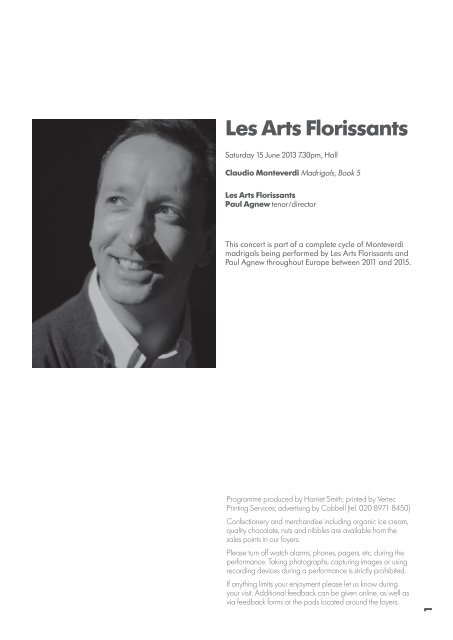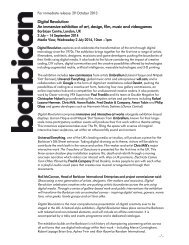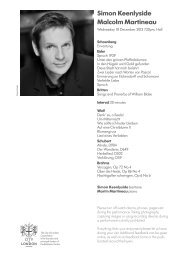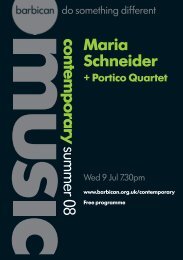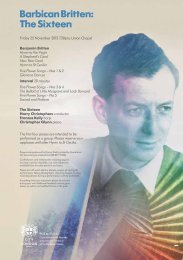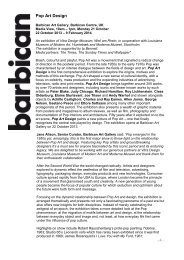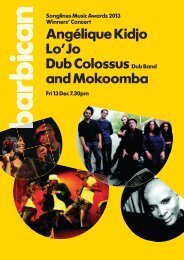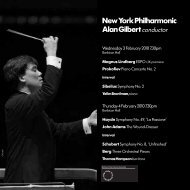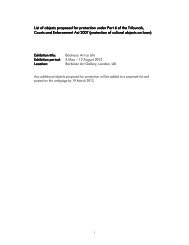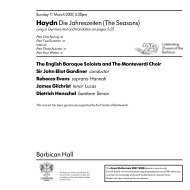Les Arts Florissants - Barbican
Les Arts Florissants - Barbican
Les Arts Florissants - Barbican
Create successful ePaper yourself
Turn your PDF publications into a flip-book with our unique Google optimized e-Paper software.
1<br />
<strong>Les</strong> <strong>Arts</strong> <strong>Florissants</strong><br />
Saturday 15 June 2013 7.30pm, Hall<br />
Claudio Monteverdi Madrigals, Book 5<br />
<strong>Les</strong> <strong>Arts</strong> <strong>Florissants</strong><br />
Paul Agnew tenor/director<br />
This concert is part of a complete cycle of Monteverdi<br />
madrigals being performed by <strong>Les</strong> <strong>Arts</strong> <strong>Florissants</strong> and<br />
Paul Agnew throughout Europe between 2011 and 2015.<br />
Programme produced by Harriet Smith; printed by Vertec<br />
Printing Services; advertising by Cabbell (tel. 020 8971 8450)<br />
Confectionery and merchandise including organic ice cream,<br />
quality chocolate, nuts and nibbles are available from the<br />
sales points in our foyers.<br />
Please turn off watch alarms, phones, pagers, etc. during the<br />
performance. Taking photographs, capturing images or using<br />
recording devices during a performance is strictly prohibited.<br />
If anything limits your enjoyment please let us know during<br />
your visit. Additional feedback can be given online, as well as<br />
via feedback forms or the pods located around the foyers.
Luca Marenzio (1553/4–99)<br />
Sinfonia (from Intermedio II,<br />
La pellegrina, 1589)<br />
Donne, il celeste lume (Il quarto libro<br />
de madrigali a sei voci, 1587)<br />
Sinfonia (from Intermedio II,<br />
La pellegrina)<br />
Claudio Monteverdi<br />
(1567–1643)<br />
Il quinto libro de madrigali a cinque<br />
voci (1605):<br />
Cruda Amarilli, che col nome<br />
ancora<br />
O Mirtillo, Mirtillo anima mia<br />
Era l’anima mia<br />
Emilio de’ Cavalieri<br />
(c1550–1602)<br />
Sinfonia (from end of Act 2,<br />
Rappresentatione di Anima, e di<br />
Corpo, 1600)<br />
Claudio Monteverdi<br />
Il quinto libro de madrigali a cinque<br />
voci:<br />
Ecco, Silvio – Prima parte<br />
Ma, se con la pietà – Seconda<br />
parte<br />
Dorinda, ah, dirò mia – Terza<br />
parte<br />
Ecco, piegando le genocchie –<br />
Quarta parte<br />
Ferir quel petto, Silvio? – Quinta<br />
e ultima parte<br />
Luca Marenzio<br />
Sinfonia (from Intermedio II,<br />
La pellegrina)<br />
interval 20 minutes<br />
Claudio Monteverdi<br />
Il quinto libro de madrigali a cinque<br />
voci:<br />
Ch’io t’ami – Prima parte<br />
Deh, bella e cara – Seconda parte<br />
Ma tu, più che mai dura – Terza e<br />
ultima parte<br />
Emilio de’ Cavalieri<br />
Sinfonia (from end of Act 2,<br />
Rappresentatione di Anima, e di<br />
Corpo)<br />
Claudio Monteverdi<br />
Il quinto libro de madrigali a cinque<br />
voci:<br />
Che dar più vi poss’io?<br />
M’è più dolce il penar per Amarilli<br />
Ahi, come a un vago sol<br />
Troppo ben può questo tiranno<br />
Amore!<br />
Amor, se giusto sei<br />
T’amo, mia vita!<br />
E così, a poco a poco (for six<br />
voices)<br />
Sinfonia. Questi vaghi concenti<br />
(for nine voices)<br />
Musical editions prepared by<br />
Pascal Duc (<strong>Les</strong> <strong>Arts</strong> <strong>Florissants</strong>)<br />
<strong>Les</strong> <strong>Arts</strong> <strong>Florissants</strong><br />
Soprano<br />
Miriam Allan<br />
Maud Gnidzaz<br />
Hannah Morrison<br />
Mezzo-soprano<br />
Stéphanie Leclercq<br />
Lucile Richardot<br />
Tenor<br />
Paul Agnew<br />
Sean Clayton<br />
Bass<br />
Lisandro Abadie<br />
Marduk Serrano López<br />
Violin<br />
Myriam Gever<br />
Sophie Gevers-Demoures<br />
Viola<br />
Galina Zinchenko<br />
Simon Heyerick<br />
Viola da gamba<br />
Anne-Marie Lasla<br />
Basso continuo<br />
Archulute<br />
Thomas Dunford<br />
Lute<br />
Massimo Moscardo<br />
Harpsichord<br />
Florian Carré<br />
Language coach<br />
Rita de Letteriis<br />
<strong>Barbican</strong> Classical Music Podcast<br />
Catherine Bott travels to Paris to talk exclusively to Paul<br />
Agnew about the controversy that surrounded Monteverdi’s<br />
Fifth Book of Madrigals at the time of its composition, the<br />
music’s extraordinary depth of passion and the genesis of<br />
the world’s first opera.<br />
Available on iTunes, Soundcloud and the <strong>Barbican</strong> website<br />
2
‘Harsh and little pleasing to the ear’:<br />
Monteverdi’s Fifth Book of Madrigals<br />
On 16 November 1598, a group<br />
of composers and performers<br />
gathered at the house of the<br />
nobleman Antonio Goretti in<br />
Ferrara. Many of the assembled<br />
company were visitors to the north<br />
Italian city, there to take part in the<br />
wedding festivities for Margaret of<br />
Austria, sister of the future Emperor<br />
Ferdinand II, and Philip III, king<br />
of Spain and Portugal. Details of<br />
what they heard appeared two<br />
years later in a book of music<br />
theory by Giovanni Maria Artusi,<br />
a canon regular of San Salvatore<br />
in Bologna and former pupil<br />
of the composer and influential<br />
theorist Gioseffo Zarlino. Artusi’s<br />
text, presented in the form of a<br />
dialogue, included an account of<br />
Goretti’s impromptu concert of new<br />
madrigals, supposedly reported to<br />
the author by the ‘Austrian Luca’.<br />
‘The madrigals were sung and<br />
repeated, but without giving the<br />
name of the author,’ Luca recalled.<br />
‘The texture was not unpleasing.<br />
But … in so far as it introduced<br />
new rules, new modes and new<br />
turns of phrase, these were harsh<br />
and little pleasing to the ear.’<br />
Artusi provided music examples<br />
for three of the offending<br />
madrigals and attacked their use<br />
of certain dissonances ‘in so open<br />
and exposed a manner’. The<br />
compositions, although presented<br />
anonymously in Artusi’s treatise,<br />
would have been widely recognised<br />
as the work of Claudio Monteverdi.<br />
Their supposed shortcomings<br />
included breaches of the golden<br />
rules of harmony and counterpoint,<br />
established and refined over<br />
several generations by composers<br />
such as Adrian Willaert, Cipriano<br />
de Rore and Palestrina and<br />
codified by Zarlino. Artusi subjected<br />
passages from Monteverdi’s<br />
‘Cruda Amarilli, che col nome<br />
ancora’ to particularly severe<br />
criticism. The work, published as<br />
the opening piece in its composer’s<br />
Fifth Book of Madrigals, baffled<br />
Artusi. Its heightened expression<br />
may have been conceived to<br />
please the ear – but that was no<br />
excuse for subverting the rational<br />
rules of textbook composition.<br />
Monteverdi and the ‘moderns’<br />
pushed Artusi and the two<br />
characters in his dialogue to lament<br />
the ‘barbarisms’ and ‘imperfections’<br />
to be found in works by fashionable<br />
‘new inventors’. The so-called<br />
Artusi–Monteverdi controversy,<br />
like so many of today’s culture<br />
wars, was fought over the ground<br />
of convention, pitching tradition<br />
against innovation, academic rigour<br />
against creative freedom. The scale<br />
and substance of Artusi’s attack,<br />
magnified with the publication of<br />
his second anti-modern treatise in<br />
1603, prompted Monteverdi to set<br />
out the case for musical modernity<br />
in print. His response was much<br />
more than a salve for wounded<br />
pride; in fact, it helped define and<br />
clarify what the musicologist Claude<br />
V. Palisca aptly described as ‘one<br />
of the deepest crises in musical<br />
composition’. Monteverdi’s Fifth<br />
Book of Madrigals, published in<br />
Venice in 1605, contains a short<br />
introductory essay in which the<br />
composer announces his intention<br />
to issue a treatise called Seconda<br />
pratica, overo Perfettione della<br />
moderna musica (‘Second practice,<br />
or perfection of the modern music’).<br />
The ‘second practice’ in question,<br />
Monteverdi explained, differed<br />
from the generally accepted<br />
practice of counterpoint established<br />
in various works of the mid-1500s<br />
by Gioseffo Zarlino. ‘Some,<br />
not suspecting that there is any<br />
practice other than that taught<br />
by [Zarlino],’ he continued, ‘will<br />
wonder at this [second practice],<br />
but let them be assured that, with<br />
regard to the consonances and<br />
dissonances, there is still another<br />
way of considering them, different<br />
from the established way, which,<br />
with satisfaction to reason and<br />
the senses, defends the modern<br />
method of composing.’ Although<br />
Monteverdi never completed his<br />
theory book, the essay in his Fifth<br />
Book served as a manifesto for the<br />
‘new music’. Its principal point was<br />
underlined in 1607 in a printed<br />
statement by the composer’s<br />
brother, Giulio Cesare Monteverdi,<br />
who noted that the purpose of<br />
breaking time-honoured rules of<br />
counterpoint ‘has been (in this kind<br />
of music) to make the [poetic text]<br />
the mistress of the [music] and<br />
not the servant’. Giulio Cesare<br />
cited Luca Marenzio and Emilio<br />
de’ Cavalieri among those who, like<br />
his brother, understood the need<br />
to direct melody and harmony to<br />
the service of poetic expression.<br />
Monteverdi’s Fifth Book of<br />
Madrigals opened with a letter<br />
3 Programme note
of dedication to his employer,<br />
Vincenzo Gonzaga, Duke of<br />
Mantua. In it, the composer noted<br />
how the nobleman had ‘not<br />
scorned’ to hear his madrigals<br />
‘many times in [his] royal<br />
chambers while they were written<br />
in manuscript and … gave sign<br />
of welcoming them with singular<br />
favour’. He hoped that the printed<br />
pieces would, ‘under the protection<br />
of so great a prince … live an<br />
eternal life to the shame of those<br />
tongues which seek to bring death<br />
to the works of others’. Artusi<br />
and his followers were clearly<br />
in Monteverdi’s mind here. The<br />
works of the Fifth Book have much<br />
in common with the composer’s<br />
Fourth Book of Madrigals of 1603,<br />
in terms of musical style, emotional<br />
breadth and choice of verse: 10<br />
of the pieces in the Fourth Book<br />
and nine in the Fifth set texts by<br />
the poet, diplomat and courtier<br />
Battista Guarini, including tales<br />
of unrequited love and loss from<br />
his pastoral tragicomedy Il pastor<br />
fido (‘The faithful shepherd’) of<br />
c1580–5. What sets the Fifth Book<br />
apart from its predecessor was<br />
Monteverdi’s inclusion of a basso<br />
continuo for the harpsichord,<br />
chitarrone or other similar<br />
instrument, which he intended<br />
specifically for the last six madrigals<br />
and for the others ad libitum. The<br />
composer’s addition of parts for<br />
instruments reflected the emerging<br />
practice of converting polyphonic<br />
madrigals into solo songs with<br />
instrumental accompaniment,<br />
among the experiments that led<br />
to the proliferation of monody in<br />
such theatrical works as Cavalieri’s<br />
Rappresentatione di Anima, e di<br />
Corpo and the two settings of<br />
Rinuccini’s Euridice composed by<br />
Caccini and Peri for the marriage<br />
of Marie de’ Medici to Henry IV<br />
of France in October 1600.<br />
Artusi’s criticisms of ‘Cruda Amarilli’<br />
no doubt influenced Monteverdi’s<br />
decision to place the work at the<br />
beginning of the Fifth Book. The<br />
madrigal’s sudden and unresolved<br />
dissonances, mostly delivered<br />
on strong beats, and striking<br />
chromatic inflections, speak for a<br />
musico-poetic art form of inventive<br />
freshness and intense expression.<br />
‘O Mirtillo, Mirtillo anima mia’<br />
echoes and amplifies the harmonic<br />
richness of ‘Cruda Amarilli’, notably<br />
so in the dissonances used to carry<br />
the words ‘che chiami crudelissima<br />
Amarilli’. Monteverdi here creates<br />
an opening diptych of tremendous<br />
emotional power, exploring the<br />
interior wounds inflicted by love<br />
on the shepherdess Amaryllis<br />
and the shepherd Mirtillo. The<br />
composer also explores Guarini’s<br />
dialogues for the ill-matched rustics<br />
Silvio and Dorinda, developing<br />
a dramatic framework for their<br />
story in the five madrigals from<br />
‘Ecco, Silvio’ to ‘Ferir quel petto,<br />
Silvio?’ Monteverdi brings the<br />
couple’s narrative to life with<br />
colourful dissonances and, above<br />
all, through his imaginative use of<br />
polyphonic declamation. The spirit<br />
of theatrical interplay also rules<br />
the following group of madrigals,<br />
projected with potent force in<br />
Mirtillo’s self-pitying laments to his<br />
beloved, the bipartite ‘Ch’io t’ami’<br />
and ‘Ma tu, più che mai dura’.<br />
The last half dozen pieces of the<br />
Fifth Book belong to the category<br />
of continuo madrigals. Monteverdi<br />
here uses various permutations<br />
of instruments and voices to build<br />
extended musical structures, which<br />
in turn support bold contrasts of<br />
texture and expressive tone. He also<br />
employs vocal virtuosity to heighten<br />
rhetorical flourishes in his chosen<br />
texts and possibly to counterbalance<br />
the more reserved vocal style of the<br />
collection’s a cappella madrigals.<br />
As the scholar Gary Tomlinson has<br />
noted, Monteverdi’s first continuo<br />
pieces provided him with ‘the means<br />
to inject a novel representational<br />
realism and immediacy into the<br />
traditional madrigalian framework<br />
of five voices’. The composer<br />
variously exploited those means<br />
in his Fifth Book, marking a clear<br />
break with the style of the foregoing<br />
a cappella madrigals in ‘Ahi, come<br />
a un vago sol’, while retaining<br />
a connection with the past in its<br />
4
haunting ensemble refrain, ‘Ah,<br />
che piaga d’Amor’. Vocal virtuosity<br />
and melodic eloquence serve<br />
the cause of textual expression in<br />
‘Amor, se giusto sei’ and ‘T’amo,<br />
mia vita!’, arguably the richest<br />
jewels in the Fifth Book’s crown.<br />
<strong>Les</strong>sons learned here were soon put<br />
to use by Monteverdi in works of a<br />
larger scale, among them Orfeo,<br />
the first great landmark of opera.<br />
Echoes of Venetian polychoral<br />
motets and other works conceived<br />
for multiple groups of singers<br />
and instrumentalists sound in the<br />
closing composition of this book.<br />
It has been suggested that ‘Questi<br />
vaghi concenti’, written for nine<br />
voices and strings, may have been<br />
created as a showpiece to launch<br />
the new madrigal collection’s<br />
publication in Mantua, although<br />
no evidence survives to support this<br />
claim. Whatever the work’s origins,<br />
its use of antiphonal ensembles<br />
and various permutations of<br />
soloists signals Monteverdi’s<br />
progressive credentials.<br />
As a prodigiously talented<br />
teenager, Claudio Monteverdi<br />
explored and imitated the style of<br />
other composers in the process<br />
of finding his own musical voice.<br />
He followed the lead of Luca<br />
Marenzio and Luzzasco Luzzaschi<br />
in his First Book of Madrigals of<br />
1587, absorbing lasting lessons<br />
from Marenzio’s high-spirited<br />
canzonettas for three voices.<br />
Marenzio, around a dozen years<br />
older than Monteverdi, delighted<br />
in the musical setting of individual<br />
words, poetic imagery and even<br />
the sounds of nature. His late<br />
madrigals, published in the second<br />
half of the 1590s, are part of the<br />
great shift away from Zarlino’s<br />
rulebooks towards a new world<br />
of expressive composition, rich in<br />
audacious chromatic harmonies<br />
and arresting dissonances. ‘Donne,<br />
il celeste lume’ from Marenzio’s<br />
Fourth Book of Madrigals of<br />
1587 probably began life as a<br />
musical intermedio or interlude for<br />
Cristoforo Castelletti’s comedy Le<br />
stravaganze d’amore (‘The vagaries<br />
of love’), first performed during<br />
carnival season at the Duke of<br />
Sora’s palace in Rome in March<br />
1585. Marenzio appears to have<br />
been invited to compose the last<br />
of five madrigals in Castelletti’s<br />
entertainment. His response is a<br />
vivacious showpiece for nine voices.<br />
Marenzio’s other surviving works<br />
for theatrical performance were<br />
written in 1589 for the lavish<br />
wedding festivities convened in<br />
Florence for the marriage of Grand<br />
Duke Ferdinando de’ Medici and<br />
the French princess Christine of<br />
Lorraine. La pellegrina (‘The Pilgrim<br />
Woman’), a composite dramatic<br />
work crafted by a group of<br />
outstanding composers, librettists,<br />
instrumentalists and singers, stood<br />
as a landmark for the emerging<br />
new music of emotional expression.<br />
The lyrical Sinfonia to Pellegrina’s<br />
second intermedio sets the scene<br />
for the contest between the Muses<br />
and the Pierians, a mythic singing<br />
competition and eternal metaphor<br />
for the power of artistic inspiration.<br />
The multi-talented composer,<br />
dancer, diplomat and administrator<br />
Emilio de’ Cavalieri, a member of<br />
an aristocratic Roman family, was<br />
charged with the task of overseeing<br />
the 1589 Florentine intermedi and<br />
with contracting the composers<br />
for La pellegrina. Cavalieri turned<br />
this experience to good use when<br />
he wrote the Rappresentatione di<br />
Anima, et di Corpo in 1600, the first<br />
surviving play entirely set to music.<br />
In addition to instrumental sinfonias,<br />
Cavalieri’s Rappresentatione<br />
included speech-like recitatives,<br />
simple and virtuoso madrigals<br />
and solo songs, a pattern soon to<br />
be developed in the new medium<br />
of opera. Although theoreticians<br />
and composers continued to<br />
debate musical style for many<br />
years, it was already clear by the<br />
time of the Rappresentatione that<br />
the expressive art of the ‘second<br />
practice’ stood for music’s future.<br />
Programme note © Andrew Stewart<br />
For texts, see page 6.<br />
5 Programme note
Texts<br />
Luca Marenzio<br />
Donne, il celeste lume<br />
Donne, il celeste lume<br />
de gl’occhi vostri, che sì dolce splende,<br />
I nostri petti accende;<br />
ma l’alma dentro a le gran fiamme vive<br />
non sface, anzi di lor si nutre e vive.<br />
Stravaganza d’amore,<br />
ch’arda in eterno, e mai non strugga un core.<br />
Ladies, the celestial light<br />
Ladies, the celestial light<br />
of your eyes, a light that gleams so soft,<br />
sets our hearts ablaze;<br />
yet amid the bright and leaping flames<br />
the soul dies not, but feeds upon them and lives.<br />
‘Tis a vagary of love,<br />
that a heart may burn eternally and be not consumed.<br />
Cristoforo Castelletti: Le stravaganze d’amore, Act IV<br />
scene 17<br />
Claudio Monteverdi<br />
Fifth Book of Madrigals<br />
Cruda Amarilli<br />
Cruda Amarilli, che col nome ancora<br />
d’amar, ahi lasso, amaramente insegni;<br />
Amarilli, del candido ligustro<br />
più candida e più bella,<br />
ma de l’aspido sordo<br />
e più sorda e più fera e più fugace,<br />
poi che col dir t’offendo<br />
i’ mi morrò tacendo.<br />
Cruel Amaryllis<br />
Cruel Amaryllis, your very name, alas,<br />
betokens the bitterness of love;<br />
Amaryllis, paler and more beautiful<br />
than the pale privet flower,<br />
yet wilder, more elusive and unhearing<br />
than the deaf serpent,<br />
since by speaking I offend you,<br />
in silence shall I die.<br />
Battista Guarini: Il pastor fido, I, 2<br />
O Mirtillo<br />
O Mirtillo, Mirtillo anima mia,<br />
se vedessi qui dentro<br />
come sta il cor di questa<br />
che chiami crudelissima Amarilli,<br />
so ben che tu di lei<br />
quella pietà che da lei chiedi avresti.<br />
Oh anime in amor troppo infelici!<br />
Che giova a te, cor mio, l’esser amato?<br />
Che giova a me l’aver sì caro amante?<br />
Perché, crudo destino,<br />
ne disunisci tu, s’Amor ne stringe?<br />
E tu perché ne stringi,<br />
se ne parte il destin, perfido Amore?<br />
O Mirtillo<br />
O Mirtillo, my beloved Mirtillo,<br />
if you could but see inside<br />
the heart of the one<br />
you call cruellest Amaryllis,<br />
I know full well you would feel<br />
just that pity you beg of her.<br />
O spirits so unhappy in love!<br />
My heart, what good is it to be loved?<br />
What good to me to have so dear a lover?<br />
Why, cruel destiny,<br />
do you divide us, when Love would bind us?<br />
And why do you bind us together,<br />
when destiny divides us, perfidious Love?<br />
Battista Guarini: Il pastor fido, III, 4<br />
6<br />
Era l’anima mia<br />
Era l’anima mia<br />
già presso a l’ultim’ore,<br />
e languia come langue alma che more,<br />
quand’anima più bella e più gradita<br />
volse lo sguard’in sì pietoso giro<br />
My spirit<br />
My spirit was already approaching<br />
its final hours,<br />
and was fading like a dying soul<br />
when a most lovely and welcome spirit<br />
turned a gaze of such mercy on me
che mi mantenn’in vita.<br />
Parean dir quei bei lumi:<br />
deh, perché ti consumi?<br />
Non m’è sì car’il cor ond’io respiro<br />
come se’ tu, cor mio.<br />
Se mori, ohimè, non mori tu, mor’io.<br />
Battista Guarini: Madrigali, LXV<br />
Ecco, Silvio, colei – Prima parte<br />
Ecco, Silvio, colei che in odio hai tanto;<br />
eccola in quella guisa<br />
che la volevi a ponto.<br />
Bramastila ferir, ferita l’hai;<br />
bramastila tua preda, eccola preda;<br />
bramastila al fin morta, eccola a morte.<br />
Che vòi tu più da lei? Che ti può dare<br />
più di questo Dorinda? Ah, garzon crudo!<br />
Ah, cor senza pietà! Tu non credesti<br />
la piaga che per te mi fece Amore:<br />
puoi questa or tu negar de la tua mano?<br />
Non hai credut’il sangue<br />
ch’i’ versava per gli occhi;<br />
crederai questo che ’l mio fianco versa?<br />
Ma, se con la pietà – Seconda parte<br />
Ma, se con la pietà non è in te spenta<br />
gentilezza e valor che teco nacque,<br />
non mi negar, ti prego,<br />
anima cruda sì, ma però bella,<br />
non mi negar a l’ultimo sospiro<br />
un tuo solo sospir. Beata morte,<br />
se l’addolcissi tu con questa sola<br />
dolcissima parola,<br />
voce cortese e pia:<br />
va’ in pace, anima mia.<br />
Dorinda, ah, dirò mia – Terza parte<br />
Dorinda, ah, dirò mia, se mia non sei<br />
se non quando ti perdo e quando morte<br />
da me ricevi, e mia non fosti allora<br />
che ti potei dar vita?<br />
Pur mia dirò, ché mia<br />
sarai mal grado di mia dura sorte;<br />
e, se mia non sarai con la tua vita,<br />
sarai con la mia morte.<br />
as to spare my life.<br />
Those beautiful eyes seemed to say:<br />
‘Ah, why do you suffer so?<br />
My own heart and life are not so dear<br />
to me as are you, my love.<br />
If you die, alas, I, not you, shall perish.’<br />
Lo, Silvio – First Part<br />
Lo, Silvio, she whom you so detest;<br />
see, there she lies,<br />
just as you wanted her to.<br />
You longed to hurt her, you have done;<br />
you longed for her to be your victim, so she is;<br />
finally, you longed for her death, she is dying.<br />
What more do you want from her? What more<br />
than this can Dorinda give you? Ah, cruel youth!<br />
Ah, pitiless heart! You did not believe in<br />
the wound dealt me by Love for you:<br />
can you now deny this one, dealt by your hand?<br />
You did not believe in the life blood<br />
that poured from my eyes;<br />
will you now believe in the blood pouring from my side?<br />
Yet, if your innate kindness – Second Part<br />
Yet, if your innate kindness and courage<br />
died not when your pity did,<br />
deny me not, I beg you,<br />
cruel, yet beautiful spirit,<br />
no, at my last breath deny me not<br />
one last sigh from you. Death would be<br />
a blessing, were you to ease it<br />
with the sweetest of words,<br />
in gentle and holy tones:<br />
‘Go in peace, my love’.<br />
Dorinda, ah, shall I call you mine – Second Part<br />
Dorinda, ah, shall I call you mine,<br />
though you are only mine now that I lose you<br />
to death by my hand, and were not mine<br />
when I could have given you life?<br />
Still I shall call you mine, for you shall be so<br />
despite the cruel will of destiny;<br />
and if you cannot be mine in life,<br />
I shall claim you with my death.<br />
7 Texts
Ecco, piegando le genocchie – Quarta parte<br />
Ecco, piegando le genocchie a terra,<br />
riverente t’adoro<br />
e ti chieggio perdon, ma non già vita.<br />
Ecco li strali e l’arco;<br />
ma non ferir già tu gli occhi o le mani,<br />
colpevoli ministri<br />
d’innocente voler; ferisci il petto,<br />
ferisci questo mostro<br />
di pietad’e d’amor aspro nemico;<br />
ferisci questo cor che ti fu crudo!<br />
Eccoti il petto ignudo.<br />
Lo, I bend my knees to the ground – Fourth Part<br />
Lo, I bend my knees to the ground,<br />
reverently adore you<br />
and beg you for forgiveness, though not for my life.<br />
Here are my bow and arrows;<br />
but do not hurt my eyes or hands,<br />
offending instruments<br />
of an innocent will; pierce my breast,<br />
strike that monster<br />
inimical to love and pity;<br />
pierce the heart that was cruel to you!<br />
Behold, my naked breast.<br />
Ferir quel petto, Silvio? – Quinta e ultima parte<br />
Ferir quel petto, Silvio?<br />
Non bisognava a gli occhi miei scovrirlo,<br />
s’avevi pur desio ch’io te ’l ferissi.<br />
Oh bellissimo scoglio,<br />
già da l’onde e dal vento<br />
de le lagrime mie, de’ miei sospiri<br />
sì spesso in van percosso,<br />
è pur ver che tu spiri<br />
e che senti pietate? O pur m’inganno?<br />
Ma sii tu pur o petto molle o marmo,<br />
già non vo’ che m’inganni<br />
d’un candido alabastro il bel sembiante,<br />
come quel d’una fera<br />
oggi ha ingannato il tuo signor e mio.<br />
Ferir io te? Te pur ferisca Amore,<br />
ché vendetta maggiore<br />
non so bramar che di vederti amante.<br />
Sia benedetto il dì che da prim’arsi!<br />
Benedette le lagrime e i martiri!<br />
Di voi lodar, non vendicar, mi voglio.<br />
Pierce your breast, Silvio? – Fifth and Final Part<br />
Pierce your breast, Silvio?<br />
You were wrong to unclothe it before me<br />
if you wished me to wound it.<br />
O most handsome rock,<br />
so often vainly buffeted by<br />
the floods of my tears<br />
and the breeze of my sighs,<br />
can it be true that you are alive<br />
and capable of pity? Or am I deceived?<br />
But be your heart soft, or hard as marble,<br />
I do not want a handsome face,<br />
fair as alabaster, to deceive me,<br />
as a wild beast today<br />
deceived your lord and mine.<br />
I hurt you? Let Love hurt you,<br />
for no better vengeance can I long for<br />
than to see you in love.<br />
Blessed be the day I have yearned for!<br />
Blessed tears and suffering!<br />
Tis your praise I desire, not my vengeance.<br />
Battista Guarini: Il pastor fido, IV, 9<br />
interval: 20 minutes<br />
Ch’io t’ami – Prima parte<br />
Ch’io t’ami, e t’ami più de la mia vita,<br />
se tu no ’l sai, crudele,<br />
chiedilo a queste selve<br />
che te ’l diranno, e te ’l diran con esse<br />
le fere lor e i duri sterpi e i sassi<br />
di questi alpestri monti<br />
che ho sì spesse volte<br />
intenerito al suon de’ miei lamenti.<br />
If, cruel girl– First Part<br />
If, cruel girl, you know not<br />
that I love you, love you more than life,<br />
ask these forests<br />
and they will tell you, as will<br />
the beasts within them, the scrubland and rocks<br />
of these steep mountains<br />
so often roused to pity<br />
by the sound of my lamenting.<br />
8
Deh, bella e cara – Seconda parte<br />
Deh, bella e cara e sì soave un tempo<br />
cagion del viver mio, mentr’al ciel piacque,<br />
volgi una volta e volgi<br />
quelle stelle amorose,<br />
come le vidi mai, così tranquille<br />
e piene di pietà, prima ch’io moia;<br />
ché ’l morir mi fia dolce.<br />
E dritt’è ben che, se mi furo un tempo<br />
dolci segni di vita, or sien di morte<br />
quei belli occhi amorosi;<br />
e quel soave sguardo<br />
che mi scorse ad amare,<br />
mi scorga anco a morire;<br />
e chi fu l’alba mia<br />
del mio cadente dì l’espero or sia.<br />
Ma tu, più che mai dura – Terza e ultima parte<br />
Ma tu, più che mai dura,<br />
favilla di pietà non senti ancora;<br />
anzi t’inaspri più,<br />
quanto più prego.<br />
Così senza parlar, dunque, m’ascolti?<br />
A chi parlo infelice? A un muto sasso?<br />
S’altro non mi vòi dir, dimm’almen: mori!<br />
E morir mi vedrai.<br />
Quest’è ben, empio Amor, miseria estrema:<br />
che sì riggida ninfa<br />
non mi risponda e l’armi<br />
d’una sola sdegnosa e cruda voce<br />
sdegni di proferire<br />
al mio morire.<br />
Battista Guarini: Il pastor fido, III, 3<br />
Che dar più vi poss’io?<br />
Che dar più vi poss’io?<br />
Caro mio ben, prendete: eccovi il core,<br />
pegno de la mia fede e del mio amore.<br />
E se per darli vita a voi l’invio,<br />
no ’l lasciate morire;<br />
nudritel di dolcissimo gioire,<br />
ché vostro il fece Amor, natura mio.<br />
Non vedete, mia vita,<br />
che l’immagine vostra è in lui scolpita?<br />
Anonymous<br />
Ah, beloved, fair – Second Part<br />
Ah, beloved, fair and once my dear<br />
reason for living, when it so pleased heaven,<br />
turn once more and look at me<br />
with those loving stars,<br />
full of as much peace and mercy<br />
as I ever saw in them, before I die;<br />
so that death may come gently to me.<br />
And it is right that<br />
those fair and loving eyes<br />
that once meant life to me, now mean death;<br />
and the gentle gaze<br />
that led me to love,<br />
let it now lead me to death;<br />
and let she who was my dawn<br />
now, as I languish, be my evening star.<br />
But, harder of heart – Third and Final Part<br />
But, harder of heart than ever,<br />
you still feel not a spark of pity;<br />
indeed the more I beg,<br />
the more unrelenting you become.<br />
Can you then hear me and say nothing?<br />
To whom do I, poor wretch, speak? A dumb rock?<br />
If nothing else, at least say to me: ‘die!’<br />
And you will see me perish.<br />
Wicked Love, this is truly dreadful misery:<br />
this unfeeling nymph<br />
answers me not and<br />
you even deny me the weapons<br />
of a cruel and angry voice<br />
at my death.<br />
What more can I give you?<br />
What more can I give you?<br />
My beloved, take this: I give you my heart<br />
as a token of my faith and of my love.<br />
And as I give it to you to save its life,<br />
do not let it die;<br />
nourish it with the sweetest joy,<br />
for Love made it yours, Nature mine.<br />
Can you not see, my life,<br />
that your image is etched upon it.<br />
9 Texts
M’è più dolce il penar per Amarilli<br />
M’è più dolce il penar per Amarilli<br />
che ’l gioir di mill’altre;<br />
e se gioir di lei<br />
mi vieta il mio destino, oggi si moia<br />
per me pur ogni gioia.<br />
Viver io fortunato<br />
per altra donna mai, per altr’amore?<br />
Né, potendo, il vorrei,<br />
né, volendo, il potrei.<br />
E, s’esser può ch’in alcun tempo mai<br />
ciò voglia il mio volere,<br />
o possa il mio potere,<br />
prego il ciel ed Amor che tolto pria<br />
ogni voler, ogni poter mi sia.<br />
The pain I suffer for Amaryllis<br />
The pain I suffer for Amaryllis is sweeter<br />
than the joy felt by a thousand others;<br />
and if my destiny<br />
forbids me to have her, let all other happiness<br />
die for me today.<br />
Could I live contented<br />
for any other woman, any other love?<br />
Neither would I, if I could,<br />
nor could I, if I would.<br />
And, should it ever come to pass<br />
that I be willing,<br />
or that I be able,<br />
I beg heaven and Love first to take<br />
my will and ability from me.<br />
Battista Guarini: Il pastor fido, III, 6<br />
Ahi, come a un vago sol<br />
Ahi, come a un vago sol cortese giro<br />
de’ duo belli occhi, ond’io<br />
soffersi il primo dolce stral d’Amore,<br />
pien d’un novo desio,<br />
sì pront’a sospirar torna ’l mio core.<br />
Lasso, non val ascondersi, ch’omai<br />
conosco i segni che ’l mio cor addita<br />
de l’antica ferita.<br />
Ed è gran tempo pur che la saldai.<br />
Ah, che piaga d’Amor non sana mai!<br />
Alas, as if toward a graceful, lovely sun<br />
Alas, as if toward a graceful, lovely sun<br />
am I drawn to two beautiful eyes, from which<br />
I was struck by Love’s first dart,<br />
full of a new desire,<br />
my heart, ready for love, now returns.<br />
Alas, there is no use in hiding, for by now<br />
I know the signs that my heart gives<br />
of the old wound.<br />
And it is high time this wound closed.<br />
Ah, Love’s wounds never heal.<br />
Battista Guarini: Madrigali, CII<br />
Troppo ben può<br />
Troppo ben può questo tiranno Amore!<br />
Poi che non val fuggire<br />
a chi no ’l può soffrire.<br />
Quand’io penso talor com’arde e punge,<br />
io dico: ah, core stolto,<br />
non l’aspettar, che fai?<br />
Fuggilo, sì che non ti prenda mai.<br />
Ma, non so, com’il lusinghier mi giunge<br />
ch’io dico: ah, core sciolto,<br />
perché fuggito l’hai?<br />
Prendilo, sì che non ti fugga mai.<br />
Tyrannous Love<br />
Tyrannous Love does his work all too well!<br />
So well that in vain will those<br />
who cannot endure him try and flee.<br />
When I think of how love burns and stings,<br />
I say: ‘Ah, foolish heart,<br />
stay not, what are you doing?<br />
Run from him ere he catches you.’<br />
Somehow, though, his flattery touches me<br />
so that I say: ‘Ah, errant heart,<br />
why did you flee?<br />
Catch him ere he runs from you.’<br />
Battista Guarini: Madrigali, C<br />
10<br />
Amor, se giusto sei<br />
Amor, se giusto sei,<br />
fa’ che la donna mia<br />
anch’ella giusta sia.<br />
Io l’amo, tu il conosci ed ella il vede,<br />
ma pur mi strazia e mi trafigge il core,<br />
e per più mio dolore<br />
Love, if you are just<br />
Love, if you are just,<br />
make my lady<br />
equally fair-minded.<br />
I love her, you know it and she sees it,<br />
and yet she tortures me, pierces my heart,<br />
and has no faith in me,
e per dispreggio tuo, non mi dà fede.<br />
Non sostener, Amor, che nel tuo regno,<br />
là dove io ho sparta fede, mieta sdegno;<br />
ma fa’, giusto signore,<br />
ch’in premio del mio amor, io colga amore.<br />
Anonymous<br />
T’amo, mia vita!<br />
T’amo, mia vita! La mia cara vita<br />
dolcemente mi dice, e in questa sola<br />
sì soave parola<br />
par che trasformi lietamente il core<br />
per farmene signore.<br />
Oh, voce di dolcezza e di diletto;<br />
prendila tosto Amore;<br />
stampala nel mio petto.<br />
Spiri solo per lei l’anima mia:<br />
t’amo! Mia vita la mia vita sia.<br />
Battista Guarini: Madrigali, LXVI<br />
E così, a poco a poco (a sei voci)<br />
E così, a poco a poco,<br />
torno farfalla semplicetta al foco,<br />
e nel fallace sguardo<br />
un’altra volta mi consumo ed ardo.<br />
Ah, che piaga d’Amore<br />
quanto si cura più tanto men sana;<br />
ch’ogni fatica è vana<br />
quando fu punto un giovinetto core<br />
dal primo e dolce strale.<br />
Chi spegne antico incendio il fa immortale.<br />
Battista Guarini: Madrigali, CIV<br />
Questi vaghi concenti (a nove voci)<br />
Questi vaghi concenti<br />
che gli augelletti intorno<br />
vanno temprando a l’aparir del giorno,<br />
sono, cred’io, d’amor desiri ardenti.<br />
Sono pene e tormenti<br />
e pur fanno le selve e ’l ciel gioire<br />
al lor dolce languire.<br />
Deh, se potessi anch’io<br />
così dolce dolermi<br />
per questi poggi solitari ed ermi,<br />
che quella a cui piacer sola desio<br />
gradisse il pianger mio!<br />
Io bramerei, sol per piacer a lei,<br />
eterni i pianti miei.<br />
Anonymous<br />
injuring me, and galling you.<br />
Grant not, Love, that in your kingdom,<br />
where I have sown faith, I should gather disdain;<br />
allow me, just lord,<br />
to harvest love in return for my love.<br />
I love you, beloved!<br />
‘I love you, beloved!’ My beloved<br />
softly tells me, and with<br />
these sweet words,<br />
she seems to transform my heart with joy<br />
and make a lord of me.<br />
Oh, voice of sweetness and delight;<br />
clasp it now, Love;<br />
imprint it in my heart.<br />
Let my spirit live for her alone:<br />
I love you! Let my beloved be my life.<br />
And thus, little by little (for six voices)<br />
And thus, little by little,<br />
like a foolish moth to the flame<br />
I flutter, and in her traitorous gaze<br />
am burned and consumed once again.<br />
Ah, the more Love’s wounds heal,<br />
the more painful they become;<br />
all efforts are vain<br />
when a young man’s heart<br />
has been struck by love’s first dart.<br />
He who quenches an old flame makes it immortal.<br />
These lovely songs (for nine voices)<br />
These lovely songs<br />
that the little birds<br />
sing all around as day breaks<br />
are, for me, passionate songs of love.<br />
They are pain and torment<br />
and yet their sweet languor<br />
brings joy to the woods and the sky.<br />
Ah, if only I too could<br />
sing such sweet sorrow<br />
on these bare and lonely hills,<br />
if only she whom alone I wish to please<br />
were to welcome my lament!<br />
I would wish my weeping eternal,<br />
just to bring her pleasure.<br />
Translations by Susannah Howe. Monteverdi translations<br />
reproduced by kind permission of Naxos Rights US, Inc.<br />
11 Texts
About tonight’s performers<br />
Paul Agnew tenor/director<br />
Born in Glasgow, Paul Agnew<br />
received his initial musical education<br />
with the Birmingham Cathedral<br />
choir. He then entered Magdalen<br />
College, Oxford, where he continued<br />
his musical studies. He sang with the<br />
Consort of Musicke before joining<br />
<strong>Les</strong> <strong>Arts</strong> <strong>Florissants</strong> in 1992, making<br />
his debut as Hippolyte in Rameau’s<br />
Hippolyte et Aricie, conducted by<br />
William Christie.<br />
He went on to sing many major roles<br />
with the group, notably in Rameau’s<br />
Platée, <strong>Les</strong> Boréades and <strong>Les</strong> Indes<br />
galantes. He is regularly invited<br />
to the Edinburgh and Lufthansa<br />
festivals and the BBC Proms. He<br />
frequently sings with ensembles such<br />
as the Berlin and Royal Liverpool<br />
Philharmonic orchestras, City of<br />
Birmingham Symphony Orchestra,<br />
the Orchestra of the Komische<br />
Oper Berlin, Orchestra of the Age<br />
of Enlightenment and the Gabrieli<br />
Consort & Players. He appears with<br />
leading conductors such as Marc<br />
Minkowski, Ton Koopman, Sir John<br />
Eliot Gardiner, Philippe Herreweghe<br />
and Emmanuelle Haïm.<br />
Among the productions in which he<br />
has taken part are Lully’s Thésée<br />
(title-role) at the Théâtre des Champs-<br />
Élysées and Armide (Renaud),<br />
produced by Robert Carsen.<br />
His discography includes Beethoven<br />
Lieder, Berlioz’s L’enfance du Christ,<br />
Monteverdi’s Vespers, Charpentier’s<br />
La descente d’Orphée aux enfers and<br />
Rameau’s Grands motets.<br />
In 2006, Paul Agnew began to<br />
take on the role of musical director<br />
for certain projects with <strong>Les</strong> <strong>Arts</strong><br />
<strong>Florissants</strong>, beginning with Vivaldi’s<br />
Vespers and continuing with<br />
Handel’s odes and anthems and<br />
Lamentazione, a concert devoted to<br />
Italian Baroque polyphony. In 2010<br />
he conducted <strong>Les</strong> <strong>Arts</strong> <strong>Florissants</strong> in<br />
Purcell’s The Indian Queen. He is also<br />
co-director of Le Jardin des Voix, <strong>Les</strong><br />
<strong>Arts</strong> <strong>Florissants</strong>’ academy for young<br />
singers. This interest in the training<br />
of new generations of musicians has<br />
also led him to conduct the French<br />
Baroque Youth Orchestra.<br />
Now associate conductor of <strong>Les</strong> <strong>Arts</strong><br />
<strong>Florissants</strong>, Paul Agnew launched<br />
in 2011 a project to perform<br />
Monteverdi’s complete madrigals,<br />
which involves nearly 100 concerts<br />
and will continue into 2015.<br />
P. Kornfeld<br />
Lisandro Abadie bass<br />
Lisandro Abadie was born in Buenos<br />
Aires, Argentina. He obtained his<br />
singing diplomas at the Schola<br />
Cantorum Basiliensis (with Evelyn<br />
Tubb) and the Lucerne School of<br />
Music (with Peter Brechbühler). He<br />
was awarded the Edwin Fischer<br />
Gedenkpreis in 2006 and was a<br />
finalist in the 2008 Handel Singing<br />
Competition.<br />
In 2010 he created the title-role in<br />
Oscar Strasnoy’s Cachafaz, staged<br />
by Benjamin Lazar in Quimper,<br />
Rennes and Paris. Highlights of 2011<br />
included tours with the Orchestra of<br />
the Age of Enlightenment (Messiah),<br />
<strong>Les</strong> <strong>Arts</strong> <strong>Florissants</strong>, <strong>Les</strong> Folies<br />
Françaises and <strong>Les</strong> Talens Lyriques.<br />
Last year he returned to the London<br />
Handel Festival.<br />
He has sung under the direction<br />
of William Christie (The Fairy<br />
Queen and Landi’s Sant’Alessio),<br />
Facundo Agudín (Così fan tutte,<br />
Don Giovanni, The Magic Flute, The<br />
Marriage of Figaro, Bach’s St John<br />
Passion, the Requiems of Mozart<br />
and Fauré and Puccini’s Mass),<br />
Christophe Rousset (Pergolesi’s San<br />
12
Guglielmo), Laurence Cummings<br />
(Belshazzar and Theodora), Hervé<br />
Niquet (Marais’s Semele,which he<br />
has also recorded), Anthony Rooley<br />
(Hayes’ The Passions), Václav Luks<br />
(St Matthew Passion and Handel’s<br />
La Resurrezione), Maurice Steger<br />
(Handel’s Acis and Galatea), Jan<br />
Tomasz Adamus (Messiah) and<br />
Paul Agnew (works by Purcell and<br />
Monteverdi), among many others.<br />
He has collaborated with ensembles<br />
such as <strong>Les</strong> <strong>Arts</strong> <strong>Florissants</strong>, Collegium<br />
1704 and Mala Punica, and regularly<br />
performs with the pianist and<br />
composer Paul Suits.<br />
Notable among Lisandro Abadie’s<br />
discography are his recording of<br />
Hayes’ The Passions,which received<br />
a Choc de Classica award, and<br />
the premiere recording of Christian<br />
Favre’s Requiem.<br />
Miriam Allan soprano<br />
Born in Newcastle, New South<br />
Wales, Miriam Allan has been based<br />
in England since 2003.<br />
She has been a soloist with leading<br />
orchestral and choral organisations<br />
from all over the world, including<br />
the Monteverdi Choir and<br />
English Baroque Soloists, London<br />
Baroque, <strong>Les</strong> <strong>Arts</strong> <strong>Florissants</strong>,<br />
Auckland Philharmonia, Concerto<br />
Copenhagen, Il Fondamento,<br />
Gewandhaus Kammerchor, Leipzig<br />
Kammerorchester, Concerto<br />
Köln, ChorWerk Ruhr, Sydney<br />
Philharmonia Choirs, Australian<br />
Chamber Orchestra, Chacona and<br />
Arcadia.<br />
She has worked with many of the<br />
leading directors and conductors<br />
of today, including Sir John Eliot<br />
Gardiner, Lars Ulrik Mortensen,<br />
Laurence Cummings, William Christie<br />
and Roy Goodman. She appears<br />
on numerous recordings, highlights<br />
of which include Pinchgut Opera’s<br />
Fairy Queen and Dardanus, The<br />
Wonders of the World with Echo du<br />
Danube and Mozart’s Requiem with<br />
the Leipzig Kammerorchester and<br />
Gewandhaus Kammerchor.<br />
In 2009 she toured Australia with<br />
Ironwood Ensemble and performed<br />
Messiah with the Queensland and<br />
Melbourne Symphony orchestras,<br />
directed by Stephen Layton. After<br />
making her debut with Glyndebourne<br />
Festival Opera in Purcell’s The Fairy<br />
Queen in 2009, she continued with<br />
that production to Paris, Caen and<br />
New York in 2010.<br />
Recent highlights include <strong>Les</strong> <strong>Arts</strong><br />
<strong>Florissants</strong>’ ongoing Monterverdi<br />
madrigal project, a return to<br />
Australia for performances with the<br />
Melbourne Symphony Orchestra,<br />
her debut with the Bach Collegium<br />
Japan, under Masaaki Suzuki, and<br />
the role of Costanza in Pinchgut<br />
Opera’s production of Vivaldi’s<br />
Griselda. This year she appears<br />
with Le Concert d’Astrée and<br />
gives concerts with the Sydney<br />
Philharmonia Choirs and Collegium<br />
Musicum, Perth.<br />
Miriam Allan is a vocal coach at<br />
Westminster Abbey and Head<br />
of Singing at Bloxham School,<br />
Oxfordshire.<br />
Sean Clayton tenor<br />
Sean Clayton trained at the<br />
Birmingham Conservatoire and<br />
London’s Royal College of Music.<br />
His operatic roles have included<br />
Elder Gleaton (Carlisle Floyd’s<br />
Susannah) and Don Eusebio (Rossini’s<br />
L’occasione fa il ladro) for Wexford<br />
Festival Opera; Apollo (Semele)<br />
for British Youth Opera; Shepherd<br />
(Orfeo) for English Bach Festival<br />
Trust and English Touring Opera,<br />
as well as, for the latter, Sailor (Dido<br />
and Aeneas); Rupert Burns (The<br />
Impresario) and Toby (The Medium)<br />
for Second Movement; Fenton (The<br />
Merry Wives of Windsor) for Opera<br />
South; M. Prospect (Offenbach’s<br />
Not in front of the Waiter) for Jubilee<br />
13 About the performers
Opera; and Giocondo (Rossini’s La<br />
pietra del paragone) and Fenton<br />
(Falstaff) for Stanley Hall Opera.<br />
He has sung in concert with the<br />
Gåvle Symphony Orchestra and<br />
has also appeared with the Apollo<br />
and English Chamber orchestras,<br />
the Irish Baroque Orchestra, the<br />
London Mozart Players and the<br />
Ten Tors Orchestra, as well as at<br />
Symphony Hall, Birmingham, the<br />
Queen Elizabeth Hall, St Martin-inthe-Fields,<br />
St John’s, Smith Square,<br />
Philharmonic Hall, Liverpool, The<br />
Music Hall, Aberdeen, and most<br />
of the major UK cathedrals.<br />
Recent and current engagements<br />
include Little Bat (Susannah) for<br />
English Touring Opera; Sandy (The<br />
Lighthouse) at the Montepulciano<br />
Festival; Aurelius (King Arthur) for<br />
Der Lautten Compagney; and The<br />
Fairy Queen in Aix-en-Provence.<br />
He has also toured with <strong>Les</strong> <strong>Arts</strong><br />
<strong>Florissants</strong> in works such as Purcell’s<br />
Dido and Aeneas, The Indian Queen<br />
and The Fairy Queen, Charpentier’s<br />
Actéon and Monteverdi madrigals.<br />
she also studied singing with<br />
Anne-Marie Blanzat, before<br />
specialising in Baroque music,<br />
attending masterclasses given by<br />
Kenneth Weiss, Howard Crook,<br />
Michel Laplénie, Jean Tubéry<br />
and Sophie Boulin. She then<br />
studied in Amsterdam with Valérie<br />
Guillorit and Elène Golgevit.<br />
She has appeared with such<br />
ensembles as Solistes XXI,<br />
Sagittarius, Ludus Modalis, A Sei<br />
Voci, Cappella Mediterranea and<br />
La Capella Reial de Catalunya.<br />
As a member of <strong>Les</strong> <strong>Arts</strong> <strong>Florissants</strong><br />
she has sung in Charpentier’s<br />
David et Jonathas and Motet<br />
pour une longue offrande (which<br />
she has also recorded), Purcell<br />
anthems and The Fairy Queen<br />
and Bach’s Christmas Oratorio.<br />
Under the direction of Paul<br />
Agnew she has participated in<br />
the Monteverdi madrigal project<br />
since its inception, in 2011.<br />
Highlights this season<br />
include concerts conducted<br />
by Gilbert Bezzina and<br />
Leonardo García Alarcón.<br />
University and Conservatoire. She<br />
subsequently joined Jean-Claude<br />
Malgoire’s Atelier Lyrique de<br />
Tourcoing. Under his leadership she<br />
made her debut at La Scala, Milan,<br />
in Vivaldi’s Vespers (1994) and at<br />
the Théâtre des Champs-Élysées in<br />
Mozart’s Da Ponte operas (1996).<br />
She came to the attention of<br />
Gabriel Garrido, who gave her<br />
a role in Cavalli’s Ercole amante<br />
at the 2005 Ambronay Festival.<br />
Away from the opera house<br />
she has sung in Duruflé’s<br />
Requiem and Bach’s cantatas<br />
and St Matthew Passion.<br />
Six years ago she set up Providencia,<br />
an ensemble dedicated to exploring<br />
newly discovered sacred repertoire<br />
of the High Middle Ages in<br />
collaboration with musicologists.<br />
Though Stéphanie Leclercq is<br />
particularly associated with early<br />
music, she has also sung the titlerole<br />
in Offenbach’s La Grande<br />
Duchesse de Gérolstein and<br />
Carmen in La tragédie de Carmen,<br />
an adaptation of Bizet’s opera by<br />
Marius Constant and Peter Brook.<br />
Among the many leading<br />
directors with whom she works<br />
are Malgoire, Garrido, Jérémie<br />
Rhorer, Vincent Dumestre, Françoise<br />
Lasserre, Oswald Sallaberger<br />
and Dominique Debart.<br />
Maud Gnidzaz soprano<br />
Maud Gnidzaz’s earliest studies<br />
were in the flute, as well as singing<br />
in a number of children’s operas.<br />
While working towards her<br />
diploma at the École du Louvre,<br />
Stéphanie Leclercq<br />
mezzo-soprano<br />
Born in France, Stéphanie Leclerq<br />
began her musical education in Lille,<br />
continuing her studies at the city’s<br />
14<br />
Ledroit-Perrin
Hannah Morrison soprano<br />
The Scottish-Icelandic soprano<br />
Hannah Morrison studied the<br />
piano and singing at the Maastricht<br />
Academy of Music and completed<br />
her singing studies at the Cologne<br />
Academy of Music with Barbara<br />
Schlick and with Rudolf Piernay at<br />
the Guildhall School of Music &<br />
Drama. She also participated in<br />
masterclasses with Matthias Goerne,<br />
Christoph Eschenbach, Roger<br />
Vignoles, Sir Thomas Allen and<br />
Dame Kiri Te Kanawa among others.<br />
She frequently sings with <strong>Les</strong><br />
<strong>Arts</strong> <strong>Florissants</strong> under Paul<br />
Agnew and William Christie.<br />
This season she tours with them<br />
to Madrid, Paris and London.<br />
In addition, she regularly works<br />
with ensembles such as the Holland<br />
Baroque Society and Christina<br />
Pluhar, L’arte del mondo under<br />
Werner Ehrhardt, Das Kleine<br />
Konzert under Hermann Max and<br />
Capella Augustina under Andreas<br />
Spering, with whom she will shortly<br />
perform Haydn’s La vera costanza.<br />
She has given a number of recitals<br />
in the UK (Oxford Festival, Kings<br />
Place and the Wigmore Hall) with<br />
the pianist Eugene Asti, with whom<br />
she has also recorded songs and<br />
duets by Mendelssohn for Hyperion.<br />
Last year she sang solo cantatas<br />
by Bach at the Bad Arolsen<br />
Baroque Festival, appeared with<br />
Christina Pluhar at the Innsbruck<br />
Early Music Festival and with<br />
Bach Collegium Japan under<br />
Masaaki Suzuki. This year she<br />
gives several concerts with Sir John<br />
Eliot Gardiner, singing in Bach’s<br />
St John’s Passion, B minor Mass and<br />
Ascension and Easter Oratorios.<br />
Hannah Morrison makes her<br />
Salzburg Festival debut in August<br />
and next year performs in<br />
Schumann’s Das Paradies und die<br />
Peri with the Leipzig Gewandhaus<br />
Orchestra, again with Gardiner.<br />
Lucile Richardot mezzo-soprano<br />
Lucile Richardot studied singing at<br />
the Paris Conservatoire and worked<br />
with, among others, Lionel Sow,<br />
Sylvain Dieudonné, Howard Crook,<br />
Margreet Honig, Noëlle Barker,<br />
Paul Esswood, Martin Isepp, Rinaldo<br />
Alessandrini, François Le Roux, Jan<br />
van Elsacker, Monique Zanetti and<br />
John Nelson. Her repertoire ranges<br />
from medieval to contemporary<br />
and she regularly sings with Solistes<br />
XXI, Correspondances, Pygmalion,<br />
l’Ensemble grégorien de Notre-<br />
Dame and appears as a soloist<br />
with Gérard <strong>Les</strong>ne, Skip Sempé,<br />
Jérôme Corréas, Patrick Cohën-<br />
Akenine, Patrick Ayrton, Gilles<br />
Colliard, Peter van Heyghen, Itay<br />
Jedlin, Benjamin Alard, Simon-<br />
Pierre Bestion and Till Aly. Last year<br />
she joined <strong>Les</strong> <strong>Arts</strong> <strong>Florissants</strong> for<br />
its Monteverdi madrigal project.<br />
Highlights to date have included<br />
Lully’s Cadmus et Hermione,<br />
the creation of the role of the<br />
First Aunt in Philippe Boesmans’<br />
Yvonne, Princesse de Bourgogne,<br />
Beat Furrer’s Wüstenbuch and<br />
her performance last year in<br />
Benjamin Hertz’s Love Box.<br />
Plans include Nono’s Prometheus<br />
in Paris, The Hague and Zurich<br />
and the role of the Spirit (Dido and<br />
Aeneas) with Le Poème Harmonique<br />
in Rouen and Versailles.<br />
Marduk Serrano López bass<br />
Born in Mexico, Marduk Serrano<br />
López initially studied cello at<br />
the Conservatorio Nacional de<br />
Música, before turning to singing,<br />
initially as a countertenor before<br />
discovering his true tessitura. In<br />
2003, fascinated by music of the<br />
17th and 18th centuries, he entered<br />
the Centre de Musique Baroque<br />
of Versailles where he earned<br />
his diploma with honours. He<br />
subsequently studied with Stéphanie<br />
Révidat and is currently working with<br />
Anna Maria Bondi. Additionally,<br />
he has undertaken courses and<br />
masterclasses with Alain Buet,<br />
Hervé Niquet, Isabelle Poulenard,<br />
15 About the performers
Maarten Koningsberger, Valérie<br />
Guillorit, Benjamin Perrot, Frédéric<br />
Desenclos and Viviane Durand.<br />
His repertoire ranges from the<br />
medieval and Baroque periods to<br />
Lied and mélodie. He also performs<br />
Latin-American folk music, in an<br />
attempt to bring it to wider attention.<br />
He has sung with ensembles<br />
including <strong>Les</strong> <strong>Arts</strong> <strong>Florissants</strong><br />
(under William Christie and Paul<br />
Agnew), Le Concert Spirituel<br />
(under Hervé Niquet) and Le<br />
Concert d’Astrée, giving concerts<br />
in Europe, Asia and America.<br />
An interest in education has<br />
led Marduk Serrano López to<br />
collaborate with conservatories<br />
and musical institutions in<br />
Mexico and Guatemala.<br />
<strong>Les</strong> <strong>Arts</strong> <strong>Florissants</strong><br />
The renowned vocal and<br />
instrumental ensemble <strong>Les</strong> <strong>Arts</strong><br />
<strong>Florissants</strong> was founded in 1979 by<br />
the Franco-American harpsichordist<br />
and conductor William Christie,<br />
and takes its name from an opera<br />
by Marc-Antoine Charpentier.<br />
Since its production of Atys by Lully<br />
at the Opéra Comique in Paris in<br />
1987, it is in the field of opera that<br />
<strong>Les</strong> <strong>Arts</strong> <strong>Florissants</strong> has found most<br />
success. Notable productions include<br />
works by Rameau (<strong>Les</strong> Indes galantes<br />
in 1990 and 1999, Hippolyte et<br />
Aricie in 1996, <strong>Les</strong> Boréades in<br />
2003, <strong>Les</strong> Paladins in 2004), Lully<br />
and Charpentier (Médée in 1993<br />
and 1994, Armide in 2008), Handel<br />
(Orlando in 1993, Acis and Galatea<br />
in 1996, Semele in 1996 and 2010,<br />
Alcina in 1999, Hercules in 2004<br />
and 2006, L’Allegro, il Moderato ed<br />
il Penseroso in 2007), Purcell (King<br />
Arthur in 1995, Dido and Aeneas<br />
in 2006, The Fairy Queen in 2010),<br />
Mozart (The Magic Flute in 1994, Die<br />
Entführung aus dem Serail in 1995)<br />
and Monteverdi, whose opera trilogy<br />
was performed at the Teatro Real in<br />
Madrid between 2008 and 2010.<br />
<strong>Les</strong> <strong>Arts</strong> <strong>Florissants</strong> has an equally<br />
high profile in the concert hall,<br />
giving concert performances of<br />
operas (Zoroastre and <strong>Les</strong> fêtes<br />
d’Hébé by Rameau, Idomenée by<br />
Campra, Jephté by Montéclair,<br />
L’Orfeo by Rossi, Susanna and<br />
Julius Caesar by Handel and The<br />
Indian Queen by Purcell), as well<br />
as secular chamber works (Actéon,<br />
<strong>Les</strong> plaisirs de Versailles and La<br />
descente d’Orphée aux enfers by<br />
Charpentier), sacred music (Grands<br />
motets by Rameau, Mondonville and<br />
Desmarest) and Handel oratorios.<br />
The ensemble has a discography<br />
of over 80 CD recordings,<br />
including the recent Lamentazione,<br />
the first recording to be<br />
conducted by Paul Agnew.<br />
For 20 years the ensemble has been<br />
artist-in-residence at the théâtre<br />
de Caen. <strong>Les</strong> <strong>Arts</strong> <strong>Florissants</strong> also<br />
tours widely within France, and<br />
is a frequent ambassador for<br />
French culture abroad, regularly<br />
appearing at the Brooklyn Academy,<br />
the Lincoln Center in New York,<br />
the <strong>Barbican</strong> Centre, the Vienna<br />
Festival and Madrid’s Teatro Real.<br />
Since <strong>Les</strong> <strong>Arts</strong> <strong>Florissants</strong>’ 30th<br />
anniversary in 2009–10, William<br />
Christie has expanded the artistic<br />
management of the ensemble by<br />
appointing two young associate<br />
conductors, Paul Agnew and<br />
Jonathan Cohen, who both<br />
now conduct <strong>Les</strong> <strong>Arts</strong> <strong>Florissants</strong><br />
each season in both small and<br />
large-scale programmes.<br />
Among other programmes<br />
marking its 2012/13 season, <strong>Les</strong><br />
<strong>Arts</strong> <strong>Florissants</strong> present in Caen,<br />
Paris and New York the production<br />
of David et Jonathas recently<br />
premiered in Aix-en-Provence, and<br />
the sixth edition of Le Jardin des Voix<br />
on international tour. It also performs<br />
Charpentier’s oratorios Caecilia<br />
virgo et martyr and Filius prodigus, as<br />
well as Handel’s oratorio Belshazzar.<br />
<strong>Les</strong> <strong>Arts</strong> <strong>Florissants</strong> receives<br />
financial support from the Ministry<br />
of Culture and Communication,<br />
the City of Caen and the Région<br />
Basse-Normandie. It is artist-inresidence<br />
at the Théâtre de Caen.<br />
IMERYS, the world leader in mineralbased<br />
specialties for industry,<br />
and ALSTOM, a global leader in<br />
the world of power generation,<br />
power transmission and rail<br />
infrastructure, are the Principal<br />
Sponsors of <strong>Les</strong> <strong>Arts</strong> <strong>Florissants</strong>.<br />
16


